Physical Address
304 North Cardinal St.
Dorchester Center, MA 02124
A cyst is a dilated, saclike cavity lined by various types of epithelia. In the vast majority of cases, cutaneous cysts are lined by one type of epithelium, most commonly stratified squamous epithelium. Infrequently, cutaneous cysts may have significant portions of more than one type of epithelium and have been given the appellation hybrid cysts . A pseudocyst, on the other hand, is a cystic cavity that lacks an epithelial lining.
The most common types of cutaneous cysts arise from adnexal structures ( Fig. 9-1 ). In fact, follicular cysts arising from the infundibular (epidermoid cysts) or isthmus portions (trichilemmal cysts) of hair follicles account for the vast majority of cutaneous cysts. Rarely, cysts are developmental in nature and arise from sequestered tissue that has failed to migrate completely during embryogenesis. The common follicular cysts are lined by stratified squamous epithelium. In contrast, cysts derived from eccrine or apocrine ducts or glands have a double layer of cuboidal to columnar epithelium. Developmental cysts have more variability in the types of epithelia that constitute their cyst linings. It is not unusual to find either pseudostratified columnar or stratified squamous epithelium (or both) in the lining of branchial cleft or bronchogenic cysts. Hence, cysts can be classified on the basis of the appendageal structure of origin, the type of epithelial lining in the cyst wall, or whether the cyst is or is not developmental in origin ( Box 9-1 ).
Infundibulum of terminal hair follicles—stratified squamous epithelium with an inner granular layer
Epidermoid (infundibular type) cyst
Proliferating epithelial (epidermoid) cyst
Verrucous cyst
Pigmented follicular cyst
Isthmus of terminal hair follicles—stratified squamous epithelium without an inner granular layer
Trichilemmal (isthmus-catagen type) cyst
Proliferating trichilemmal cyst
Verrucous cyst (occasionally trichilemmal differentiation)
Infundibulum of vellus hair follicles—stratified squamous epithelium with a granular layer
Milium
Vellus hair cysts (solitary and eruptive variants)
Sebaceous duct—stratified squamous epithelium with an inner cuticular lining
Steatocystoma (simplex and multiplex)
Eccrine duct or gland—cuboidal lining without apical snouting
Eccrine hidrocystoma
Apocrine duct or gland—cuboidal lining with apical snouting
Apocrine hidrocystoma or cystadenoma
Multiple sites of origin
Hybrid cyst
Cysts lined by stratified squamous epithelium
Dermoid cyst
Cysts lined by squamous and nonsquamous (columnar ciliated, pseudostratified columnar, or cuboidal) epithelium *
* Additional cysts in this category, which are not further discussed in this chapter, include branchial cleft cysts (lined by predominantly stratified squamous or pseudostratified columnar ciliated epithelium), bronchogenic cysts (lined predominantly by pseudostratified columnar ciliated epithelium), thyroglossal duct cysts (lined predominantly by stratified squamous epithelium), and thymic cysts (lined by stratified squamous or pseudostratified columnar ciliated or columnar epithelium).
Cutaneous ciliated cyst (predominantly columnar ciliated or cuboidal)
Ciliated mucinous cyst of the vulva (predominantly simple columnar ciliated)
Median raphe cyst (predominantly stratified or pseudostratified columnar)
Omphalomesenteric duct cyst (gastric or intestinal columnar)
Cysts lacking a lining epithelium
Pseudocyst of the auricle
Digital mucous cyst
Ganglion cyst
Mucocele or mucous cyst of the oral cavity (most cases)
Metaplastic synovial cyst
The gross appearance of cysts is not specific and can overlap with benign or malignant cystic tumors of the skin as well as noncystic lesions. For this reason, excised cysts should be submitted for routine histology to render a definitive diagnosis (i.e., to exclude a malignant cystlike tumor such as a cystic squamous cell carcinoma). After a histologic diagnosis of a benign cyst is made, no further treatment is necessary except for cosmetic reasons or because of irritation from rupture or superinfection.
A sinus is a deep invagination or tract lined by epithelium or granulation tissue. As such, sinuses may be developmental in origin or arise secondary to an exuberant inflammatory reaction. The majority of sinus tracts encountered by dermatopathologists belong to the latter group. Sinus tracts are significant because of their propensity for recurrent infection and risk for malignancy arising secondary to longstanding chronic inflammation.
Cysts arising from the infundibular portion of terminal or vellus hair follicles have an epidermoid mode of keratinization and, therefore, keratinize through a granular layer such as the epidermis. Epidermoid (infundibular) cysts, most verrucous cysts, and pigmented follicular cysts are types of cysts that originate from the follicular infundibulum of terminal hairs. Vellus hair cysts and most milia are derived from the infundibulum of vellus hair follicles.
Follicular infundibular cysts account for approximately 80% of all cutaneous cysts. They are located in the dermis of hair-bearing skin, with a predilection for the head, neck, and trunk. They are usually solitary and slow growing and are typically 1 to 5 cm in diameter. A punctum, corresponding to the opening of the cyst to the skin surface, is often seen. The cysts may be erythematous and tender if ruptured or infected. Rarely, multiple infundibular cysts are seen as a manifestation of Gardner's syndrome or the basal cell nevus syndrome. Recently developed BRAF inhibitors have been associated with development of epidermoid cysts in patients treated for advanced stage malignant neoplasms, such as melanoma.
Epidermal inclusion cysts resemble infundibular cysts but arise on the palms and soles as a result of traumatic implantation of the epidermis. Thus epidermal inclusion cysts are regarded as true epidermal cysts.
Infundibular cysts may show a connection to the surface epidermis. The cysts are lined by stratified squamous epithelium possessing an inner granular layer composed of keratinocytes containing keratohyaline granules ( Fig. 9-2 ). The orthokeratin that fills the cyst cavity has a loose and laminated appearance. Occasionally, a few terminal hair shafts are present in the lumen. No adnexal structures are seen in the cyst walls.
Most common cutaneous cyst
Adults
Multiple lesions may occur in association with Gardner's or nevoid basal cell (Gorlin's) syndrome
May occur anywhere
Most often on the face or trunk
Dermal nodule
May be inflamed, itchy, or painful
The lesions are benign but may be symptomatic or become a cosmetic issue
Simple surgical excision is the treatment of choice
Cystic structure
Lined by infundibular type epithelium with granular cell layer
Basket weave stratum corneum
Associated granulomatous reaction when ruptured
Other cysts (distinguished by type of epithelium lining the cyst wall)
Milium (small, 1-2 mm superficial dermal form of follicular cyst of infundibular type)
Keratoacanthoma or cystic squamous cell carcinoma
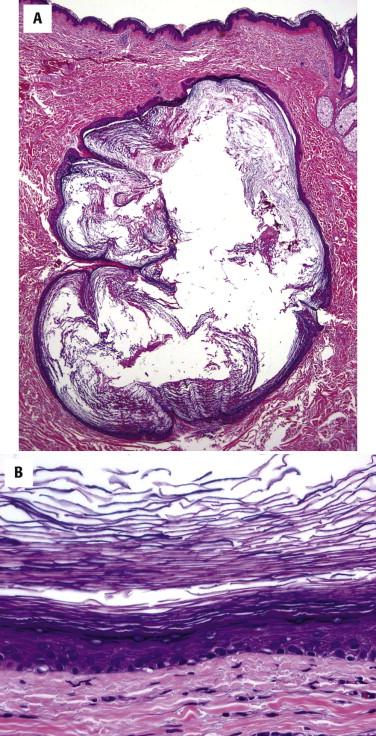
Cysts are prone to rupture, resulting in varying degrees of inflammation and scarring. When infected cysts rupture, a prominent mixed suppurative and foreign body granulomatous inflammatory response is elicited. Older lesions tend to have fewer neutrophils and more lymphocytes and plasma cells. In the absence of infection, a foreign body granulomatous reaction, composed of multinucleated foreign body giant cells and thin flakes of anucleate keratin, dominates the host response to ruptured epidermoid cysts ( Fig. 9-3 ). The cyst lining may be obliterated by the inflammatory and scarring host response.
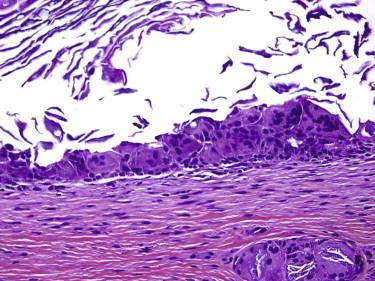
Secondary changes that may rarely be seen in follicular infundibular cysts include basal layer hyperpigmentation in dark-skinned individuals, acantholytic dyskeratosis, or epidermolytic hyperkeratosis ( Fig. 9-4 ). Some cysts have other types of epithelia, such as steatocystoma, trichilemmal cyst, or pilomatricoma, and are classified as follicular hybrid cysts (see the following).
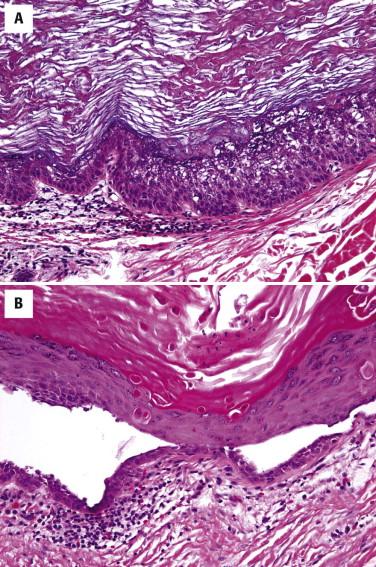
Milia are smaller (1 to 2 mm in diameter) than infundibular cysts and arise in the superficial dermis. Pigmented follicular cysts have multiple pigmented hair shafts within their cyst cavities and rete ridges extending peripherally into the dermis from the lining epithelium, which are features not typical of epidermoid cysts. Dermoid cysts show an identical cyst lining and mode of keratinization to epidermoid cysts but differ by possessing adnexal structures within the cyst wall and several hair shafts in the cyst cavity. Some squamous cell carcinomas mimic a cyst in their superficial portion.
Proliferating epithelial cysts is a term coined within the past decade to encompass both proliferating infundibular (or epidermoid) and trichilemmal cysts, the latter of which are discussed separately below. Proliferating infundibular cysts arise from preexisting infundibular cysts. In contrast to proliferating trichilemmal cysts, which have a strong predilection for the scalp, the majority (≈80%) of proliferating infundibular cysts occurs outside of the head and neck region.
Most lesions show, at least focally, a cyst lining that keratinizes like the infundibulum of the hair follicle. The cyst epithelium shows varying degrees of acanthosis, papillomatosis, hypergranulosis, parakeratosis, and hyperkeratosis. A multilocular cyst may be seen in some cases. More solid areas of proliferating epithelium tend to radiate peripherally into the surrounding dermis and are composed of keratinocytes with abundant eosinophilic cytoplasm and sharp cytoplasmic borders. When keratinization is noted in the more solid lobules, keratinocytes with keratohyaline granules form a variably thick granular layer that separates the loose laminated keratin within the cyst lumen from the remainder of the stratified squamous epithelium ( Fig. 9-5 ). Squamous eddies are commonly found. A foreign body giant cell reaction to extravasated keratin may be present. No cytologic atypia of keratinocytes or infiltrative peripheral growth patterns are seen.
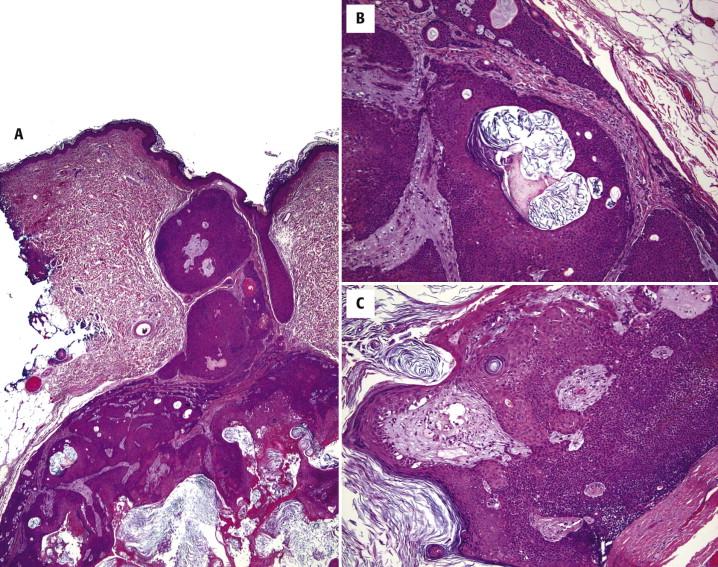
Proliferating infundibular cysts need to be distinguished from well-differentiated squamous cell carcinomas arising in or simulating a proliferating cyst. Carcinoma is diagnosed by the presence of cytologic atypia or an infiltrative growth pattern at the periphery of the cystic lesion.
Human papillomavirus (HPV)–related follicular cysts encompass two groups of cutaneous lesions, verrucous cysts and HPV-infected palmar and plantar epidermal cysts. Verrucous cysts are rare epidermal cysts that are defined histologically by verrucous changes of their stratified squamous linings. These cysts have a predilection for the face, neck, trunk, and extremities of adults. Often the cysts appear inflamed.
Verrucous cysts are lined by stratified squamous epithelium with verrucous features (papillomatous hyperplasia, hypergranulosis with large basophilic keratohyaline granules, tiers of parakeratosis overlying papillomatous processes, and HPV-cytopathic changes) ( Fig. 9-6 ). Whorls of squamous cells, or squamous eddies, are quite common.
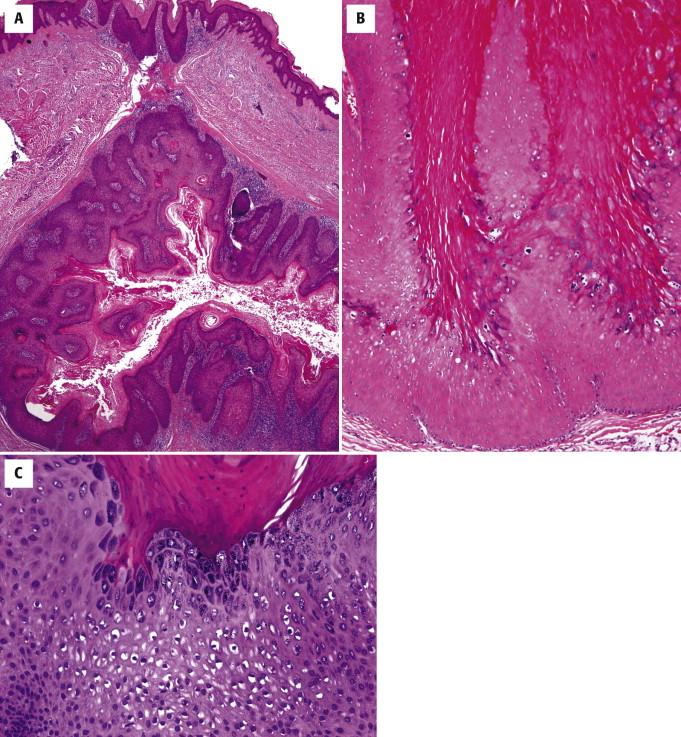
Verrucous cysts differ from epidermoid cysts by having papillomatous hyperplasia and viropathic changes.
Pigmented follicular cysts are rare and present as solitary papules or nodules. They have a predilection for the head and neck of adults but can also arise on the trunk and rarely on the extremities. Males are more commonly affected than females. As a result of their dark brown or blue hue, the clinical differential diagnoses include hidrocystoma, melanocytic lesions such as blue nevi, dermatofibroma, and pigmented basal cell carcinoma.
Pigmented follicular cysts often connect via a small pore to the surface epidermis. They are lined by stratified squamous epithelium, often with a retained rete ridge pattern, that keratinizes through a granular layer. The keratin is loose and laminated. Essential to the diagnosis is observing several terminal-sized hair shafts within the cyst cavity. The pigmented hair shafts contain abundant melanin pigment ( Fig. 9-7 ). Sebaceous lobules are not seen in the cyst wall.
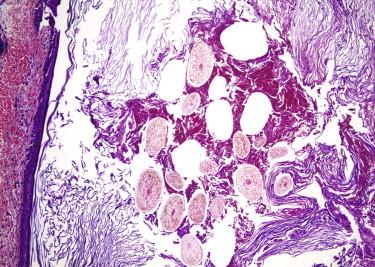
Infundibular cysts differ from pigmented follicular cysts by lacking both a rete ridge pattern in the cyst wall and multiple, pigmented hair shafts in the cyst cavity. Although eruptive vellus hair cysts have multiple hair shafts in the cyst cavity similar to pigmented follicular cysts, the hair shafts are of vellus type; that is, they are small in diameter and lack pigmentation.
Milia are small, 1 to 2 mm, white to yellow papules that are superficially located in the dermis. Primary milia arise de novo from the infundibular region of vellus hair follicles and manifest as multiple papules on the face. Infants and adults are primarily affected. Secondary milia result from scarring of the dermis caused by trauma, burns, an underlying subepidermal blistering disorder such as epidermolysis bullosa, cicatricial pemphigoid, or porphyria cutanea tarda, or after dermabrasion. Secondary milia may arise from a variety of adnexal structures, such as the infundibulum of vellus hair follicles, eccrine ducts, or implantation of the epidermis. They have a widespread distribution, occurring at sites exposed to trauma, burns, or scarring procedures, and can occur at any age. Very rarely, milia are seen in the Nicolau-Balus syndrome (milia, eruptive syringomas, and atrophoderma vermiculata) or in conjunction with trichoepitheliomas and cylindromas. Milia have also been reported in patients treated with BRAF inhibitor therapy.
Primary milia are small, thin-walled cysts in the papillary to upper reticular dermis. The cysts are lined by a thin layer of stratified squamous epithelium that keratinizes through a granular layer in an epidermoid mode ( Fig. 9-8 ). Orthokeratin within the cyst cavities is loose and laminated. Milia lack multiple vellus hair shafts in their cyst cavities. These milia may be seen in continuity with the vellus hair follicles from which they arose in serial sections. Multiple levels may be necessary if a milium is suspected but not seen on the initial levels.
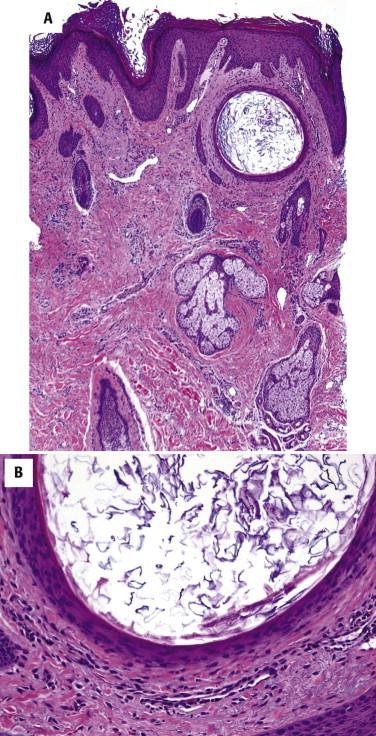
Secondary milia have many of the same histologic features as primary milia. In some cases, continuity with an underlying eccrine duct may be seen in serial sections. A scar in the dermis surrounding secondary milia is a typical feature ( Fig. 9-9 ).
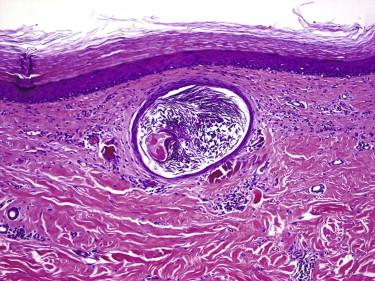
Infundibular cysts are histologically indistinguishable from milia but are larger and more deeply seated in the dermis and subcutis. Vellus hair cysts, in contrast to milia, have multiple cross-sections of vellus hair shafts within their cyst lumens.
Vellus hair cysts may occur as sporadic, solitary lesions on a nonhereditary basis. More commonly, multiple, “eruptive” vellus hair cysts occur and in some cases are inherited in an autosomal dominant manner. The lesions develop abruptly as small, red, tan, brown, or black 1- to 4-mm papules. Central umbilication may be seen. Vellus hair cysts have a predilection for the trunk, especially the chest, abdomen, and extremities, but also can be found on the neck, face, and groin.
Vellus hair cysts manifest as small cysts in the upper to mid-dermis. A thin layer of stratified squamous epithelium possessing an inner granular layer forms the cyst lining. Orthokeratin within the cyst cavity has a loose and laminated appearance. Multiple vellus hairs, characterized by small-caliber hair shafts that generally lack pigment, are admixed with the keratin within the lumen of the cyst ( Fig. 9-10 ). Occasionally, telogen hair follicles, sebaceous lobules, or small slips of arrector pili muscle may be seen in the cyst wall.
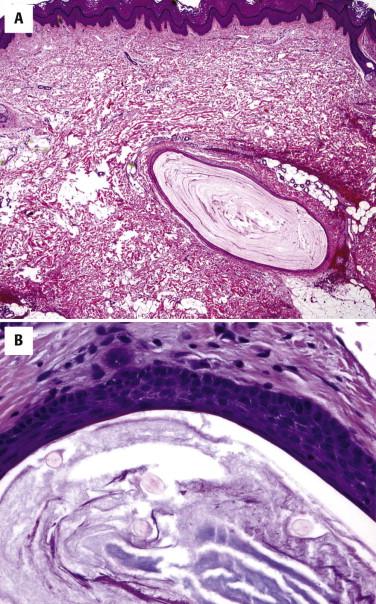
Infundibular cysts and milia show many features similar to vellus hair cysts but lack multiple, vellus-type hair shafts. Pigmented follicular cysts also share many similar features with vellus hair cysts but have terminal size hairs that contain pigment within the medullary portion of the shafts in their cyst lumens.
Cysts arising from the isthmus portion of the hair follicle have a trichilemmal mode of keratinization. In this type of keratinization, large, eosinophilic keratinocytes in the inner layer of the cyst lining give rise to compact eosinophilic keratin without an intervening granular layer. Therefore, this mode of keratinization resembles that seen in the outer root sheath of hair follicles or the sac around catagen follicles. Thus, these cysts have been referred to as trichilemmal cysts, isthmus-catagen type of follicular cysts, or pilar cysts. Sebaceous cyst is an antiquated term that is best avoided.
Trichilemmal cysts are the second most common cutaneous cysts, accounting for approximately 10% to 15% of cysts in the skin. Approximately 90% of trichilemmal cysts occur on the scalp. These cysts arise in adulthood, and women are more commonly affected than men. An autosomal dominant pattern of inheritance is common. The cysts are smooth, firm nodules, ranging from less than 1 cm to more than 5 cm in diameter. It is more common for an individual to have multiple trichilemmal cysts than a solitary cyst of the scalp. When trichilemmal cysts occur at sites other than the scalp, they are almost always solitary.
Trichilemmal cysts are lined by stratified squamous epithelium that generally lacks an inner granular layer, although it is not uncommon to find focal areas where keratinocytes possess occasional keratohyaline granules. Intercellular bridges between keratinocytes are absent within the epithelium of the cyst wall. One of the most characteristic features of trichilemmal cysts is the presence of an innermost layer of large keratinocytes with abundant eosinophilic cytoplasm that keratinize abruptly. The orthokeratin that is produced is eosinophilic and densely packed. A common finding in trichilemmal cysts is palisading of the outermost layer of the epithelium, which has a tendency to separate from the remainder of the cyst wall lining ( Fig. 9-11 ). Adnexal structures are not observed in the cyst walls.
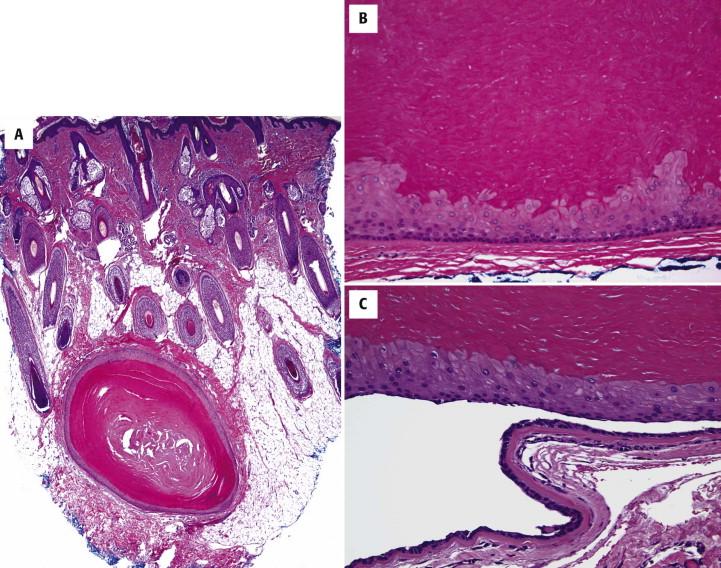
Trichilemmal cysts are prone to rupture, in which case a foreign body giant cell reaction is elicited in response to the extravasated keratin. Cholesterol clefts are usually admixed with the foreign body granulomatous reaction ( Fig. 9-12 ). Calcifications occur in the cyst cavities of approximately 25% of cases. Occasionally, cysts may demonstrate areas of trichilemmal cyst and other areas of another type of cyst, such as an epidermoid cyst, resulting in follicular hybrid cysts.
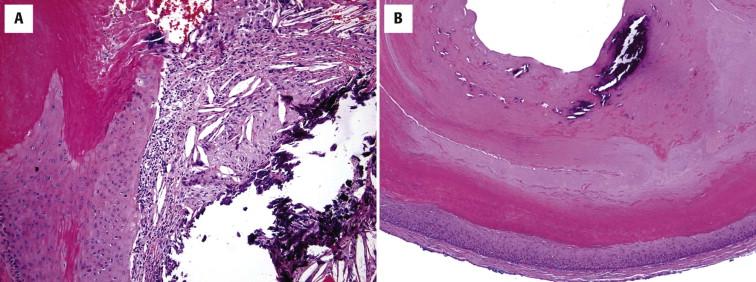
Infundibular cysts keratinize through a granular layer and produce loose and laminated keratin, in contrast to the absence of a granular layer and presence of dense, eosinophilic keratin that occur in trichilemmal cysts. The major histologic features that distinguish a proliferating trichilemmal cyst or tumor from a trichilemmal cyst are the presence of multiple, circumscribed squamous lobules, squamous eddies, some degree of nuclear atypia of squamous cells, and usually low mitotic activity in the former.
Proliferating trichilemmal cysts and tumors are almost always solitary lesions arising from a longstanding trichilemmal cyst in the dermis or upper subcutis. The vast majority of lesions occurs on the scalp, most commonly in elderly women. These lesions can vary considerably in size and occasionally exceed 10 cm in diameter. A history of rapid enlargement of a preexisting nodule is usually elicited.
Most affected patients are elderly women
90% of tumors are located on the scalp
Dermal or subcutaneous nodule
History of slow growth
May range in size from a few mm to greater than 20 cm
Indolent if no associated carcinoma is found
May locally persist or recur if incompletely removed
Treatment is by complete surgical excision
Features typical of a trichilemmal cyst are present, but the epithelial layer is thickened, and the cyst is often multiloculated. Balls of squamous cells, or squamous eddies, are usually scattered through the lesion. Some mitotic figures may be seen in the proliferative areas of the lesion, but atypical mitoses are lacking. No significant cytologic atypia or infiltrative growth pattern at the periphery is seen ( Fig. 9-13 ).
Multiloculated cyst
Lined by epithelium lacking a granular cell layer
Compact hard keratin
Thickened epithelium with interanastomosing bridges
Lobular circumscribed borders; no infiltrative growth at periphery
No significant atypia or lack of maturation
Become a Clinical Tree membership for Full access and enjoy Unlimited articles
If you are a member. Log in here